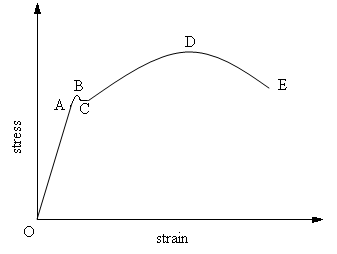Relationship between Stress
and Strain
|
4.
Relationship between Stress and Strain
Relationship between
Stress and Strain are derived on the basis of
the elastic behaviour of material
bodies.
A standard mild steel specimen is subjected to
a gradually increasing pull by Universal
Testing Machine. The stress-strain curve
obtained is as shown below.
 A -Elastic Limit
A -Elastic Limit
B - Upper Yield Stress
C - Lower Yield Stress
D -Ultimate Stress
E -Breaking Stress
|
| |
|
|
| |
4.1.
Elasticity and Elastic Limit
Elasticity of a body is the property of the body
by virtue of which the body regains its original
size and shape when the deformation force is removed.
Most materials are elastic in nature to a lesser
or greater extend, even though perfectly elastic
materials are very rare.
The maximum stress upto which a material can exhibit
the property of elasticity is called the elastic
limit. If the deformation forces applied causes
the stress in the material to exceed the elastic
limit, there will be a permanent set in it. That
is the body will not regain its original shape
and size even after the removal of the deforming
force completely. There will be some residual
strain left in it. |
| |
|
| |
Yield
stress
When a specimen is loaded beyond the elastic
limit the stress increases and reach a point
at which the material starts yielding this stress
is called yield stress.
Ultimate stress
Ultimate load is defined as maximum load which
can be placed prior to the breaking of the specimen.
Stress corresponding to the ultimate load is
known as ultimate stress.
Working stress
Working stress= Yield stress/Factor of safety.
|
| |
4.2.
Hooke’s Law
Hooke’s law states that stress is proportional
to strain upto elastic limit. If I is the stress
induced in a material and e the corresponding
strain, then according to Hooke’s law,
p / e = E, a constant.
This constant E is called the modulus
of elasticity or Young’s
Modulus, (named after the English scientist
Thomas Young).
It has later been established that Hooke’s
law is valid only upto a stress called the limit
of proportionality which is slightly
less than the elastic limit.
|
| |
4.3.
Elastic Constants
Elastic constants are used to express the relationship
between stresses and strains. Hooke’s law
, is stress/strain = a constant, within a certain
limit. This means that any stress/corresponding
strain = a constant, within certain limit. It
follows that there can be three different types
of such constants. (which we may call the elastic
constants or elastic modulae) corresponding to
three distinct types of stresses and strains.
These are given below.
(i)Modulus of Elasticity
or Young’s Modulus (E)
Modulus of Elasticity is the ratio of direct stress
to corresponding linear strain within elastic
limit. If p is any direct stress below the elastic
limit and e the corresponding linear strain, then
E = p / e.
(ii)Modulus of Rigidity
or Shear Modulus (G)
Modulus of Rigidity is the ratio of shear stress
to shear strain within elastic limit. It is denoted
by N,C or G. if q is the shear stress within elastic
limit and f the corresponding shear strain, then
G = q / f.
(iii) Bulk Modulus (K)
Bulk Modulus is the ratio of volumetric stress
to volumetric strain within the elastic limit.
If pv is the volumetric stress within elastic
limit and ev the corresponding volumetric strain,
we have K = pv / ev. |
|